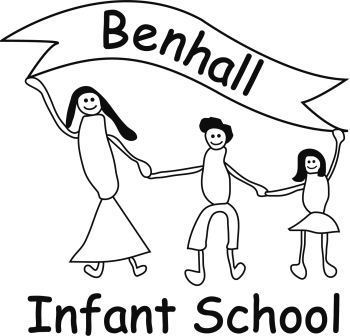Art at Benhall
At Benhall Infant School, we believe that every child is an artist. (Pablo Picasso) Art has the power to transform, to illuminate, to educate, to inspire and motivate.
Key features of effective art teaching
We understand that children need to be emersed in art in order to be inspired to create their own. We ensure that all children have access to a range of media through carefully planned provision.
The key principles of effective art teaching includes:
- Nurturing the children’s creativity
- Integrating art within provision so that they can revisit and practise taught skills
- maintaining pace of learning
- Continuous teacher assessment through objective led planning
- early identification of children at risk of falling behind, linked to the provision of effective interventions.
How we teach art
- At Pre-School, encouraged to create through a variety of media. We encourage individuality rather than children following a planned and taught outcome.
- In reception art provision responds to the children’s interests and experiences. Teachers reinforce their knowledge and skills through teacher inputs. Teachers teach the children the skills they need to discuss their work and the work of others.
- In KS1 the children and becoming more aware of a variety of techniques and artists. They are encouraged to journal their own research into artists and to show progression of their art skills.
- Regular art inputs are used to teach the sequence of knowledge and skills within expressive art and design (EYFS) and art curriculum (NC), building on prior learning.
- Art inputs last between 10 and 20 minutes.
- Children are exposed to information about a variety of artists and have opportunities to discuss their likes and dislikes.
- Provision activities, paired with objective led planning, facilitate opportunities for children to rehearse what they have learned. Teachers use these provision tasks to assess children against the learning objective – adding scaffolding to support or challenge.
- Resources and texts are high quality and support the children’s knowledge and skills within this part of the curriculum.
The child’s progression as an artist:
At Pre-school, I am a mini artist who is experimenting with my creativity using a variety of media, materials and resources. I am inspired by my immediate environment and experiences.
I am able to:
- Explore with lots of colours and see what colours I can create.
- Beginning to make simple representations.
- Choose particular colours for a purpose
In reception, I am an early artist who is confident to express my creativity using a variety of media, materials, and resources in my own unique way. I will be inspired by the rich and diverse artistic genres presented in my learning environment. I will feel safe to express and represent my thoughts, feelings and ideas that demonstrate the skills and techniques I have learnt. I will be respectful of others own unique expressions of art that are different to mine.
I am able to:
- Experiment to create different textures.
- Explore mixing primary colours to make secondary colours.
- Use colours for a specific purpose.
- Use simple tools efficiently and confidently I.e., scissors, glue sticks, pencils
- Use simple taught techniques appropriately I.e., fringing and dappling.
- Begin to combine different media to create new effects.
- Manipulate materials and tools to achieve a planned effect (watercolours, mark making, snipping, mark making, clay tools).
- Adapt my work.
- Talk about what I am doing or have done and describe it e.g. I painted a picture of an owl and pushed down on my brush to make it all fluffy. I am making a robot I used a big box for his body, and I need round bottle tops for his buttons.
- Discuss my creative ideas with others and can answer their questions.
- Use more complex taught techniques appropriately with support I.e., hinges, pop out mechanisms, split pins, sketching.
- Source and use a variety of appropriate resources. i.e. We need something fluffy for his hair, let’s go and look in the fabric box.
- Use what I have learnt about media and materials, in original ways, thinking about uses and purposes.
- Use more complex taught techniques independently.
- Use materials and resources to create props for my role-play.
In KS1, I am an artist who is confident to create with a range of techniques and media as I continue to develop my own artistic style. I am inspired by the artists that I have studied. I am confident in my own creative choices. I talk animatedly about how art makes me feel and explain my opinions on others work.
I am able to:
- Decide which media I want to use to create my art
- Practise the techniques I have been taught in a variety of pieces of work
- Share my ideas and opinions with others
- Respond to feedback from others to improve my work
- Use a sketchbook to gather and collect artwork - modelled by an adult.
- Understand the basic use of a sketchbook and work out my ideas for drawings and begin to use independently.
- Use a variety of tools effectively and with purpose, including pencils, rubbers, crayons, pastels, felt tips, charcoal, ballpoints, chalk, and other dry media.
- Layer different media, e.g., crayons, pastels, felt tips, charcoal and ballpoint.
- Begin to explore the use of line, shape, and colour.
- Experiment with the visual elements; line, shape, pattern, and colour.
- Make marks in print with a variety of objects, including natural and made objects.
- Carry out different printing techniques e.g., monoprint, block, relief, and resist printing.
- Print using a variety of materials, objects, and techniques.
- Thread a needle
- Cut, glue and trim material.
- Roll, knead and shape manipulative materials.
